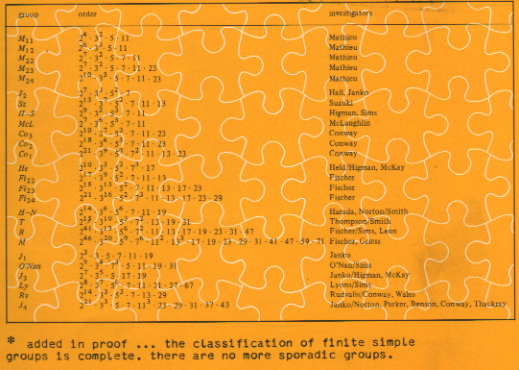 John McKay
John McKay
pointed me to a few interesting links on ‘Platonic’ solids and monstrous
moonshine. If you thought that the ancient Greek discovered the five
Platonic solids, think again! They may have been the first to give a
correct proof of the classification but the regular solids were already
known in 2000BC as some
neolithic stone artifacts discovered in Scotland show. These
Scottish solids can be visited at the Ashmolean Museum in Oxford. McKay
also points to the paper Polyhedra in physics,
chemistry and geometry by Michael Atiyah and Paul Sutcliffe. He also
found my posts on a talk I gave on monstrous moonshine for 2nd year students earlier this year and
mentionted a few errors and updates. As these posts are on my old weblog
I’ll repost and update them here soon. For now you can already hear and
see a talk given by John McKay himself 196884=1+196883, a monstrous tale at the Fields Institute.
Tag: moonshine

I
found an old copy (Vol 2 Number 4 1980) of the The Mathematical Intelligencer with on its front
cover the list of the 26 _known_ sporadic groups together with a
starred added in proof saying
- added in
proof … the classification of finite simple groups is complete.
there are no other sporadic groups.
(click on the left picture to see a larger scanned image). In it is a
beautiful paper by John Conway “Monsters and moonshine” on the
classification project. Along the way he describes the simplest
non-trivial simple group $A_5 $ as the icosahedral group. as well as
other interpretations as Lie groups over finite fields. He also gives a
nice introduction to representation theory and the properties of the
character table allowing to reconstruct $A_5 $ only knowing that there
must be a simple group of order 60.
A more technical account
of the classification project (sketching the main steps in precise
formulations) can be found online in the paper by Ron Solomon On finite simple
groups and their classification. In addition to the posts by John Baez mentioned
in this
post he has a few more columns on Platonic solids and their relation to Lie
algebras, continued here.
 Can
Can
it be that one forgets an entire proof because the result doesn’t seem
important or relevant at the time? It seems the only logical explanation
for what happened last week. Raf Bocklandt asked me whether a
classification was known of all group algebras l G which are
noncommutative manifolds (that is, which are formally smooth a la Kontsevich-Rosenberg or, equivalently, quasi-free
a la Cuntz-Quillen). I said I didn’t know the answer and that it looked
like a difficult problem but at the same time it was entirely clear to
me how to attack this problem, even which book I needed to have a look
at to get started. And, indeed, after a visit to the library borrowing
Warren Dicks
lecture notes in mathematics 790 “Groups, trees and projective
modules” and browsing through it for a few minutes I had the rough
outline of the classification. As the proof is basicly a two-liner I
might as well sketch it here.
If l G is quasi-free it
must be hereditary so the augmentation ideal must be a projective
module. But Martin Dunwoody proved that this is equivalent to
G being a group acting on a (usually infinite) tree with finite
group vertex-stabilizers all of its orders being invertible in the
basefield l. Hence, by Bass-Serre theory G is the
fundamental group of a graph of finite groups (all orders being units in
l) and using this structural result it is then not difficult to
show that the group algebra l G does indeed have the lifting
property for morphisms modulo nilpotent ideals and hence is
quasi-free.
If l has characteristic zero (hence the
extra order conditions are void) one can invoke a result of Karrass
saying that quasi-freeness of l G is equivalent to G being
virtually free (that is, G has a free subgroup of finite
index). There are many interesting examples of virtually free groups.
One source are the discrete subgroups commensurable with SL(2,Z)
(among which all groups appearing in monstrous moonshine), another
source comes from the classification of rank two vectorbundles over
projective smooth curves over finite fields (see the later chapters of
Serre’s Trees). So
one can use non-commutative geometry to study the finite dimensional
representations of virtually free groups generalizing the approach with
Jan Adriaenssens in Non-commutative covers and the modular group (btw.
Jan claims that a revision of this paper will be available soon).
In order to avoid that I forget all of this once again, I’ve
written over the last couple of days a short note explaining what I know
of representations of virtually free groups (or more generally of
fundamental algebras of finite graphs of separable
l-algebras). I may (or may not) post this note on the arXiv in
the coming weeks. But, if you have a reason to be interested in this,
send me an email and I’ll send you a sneak preview.